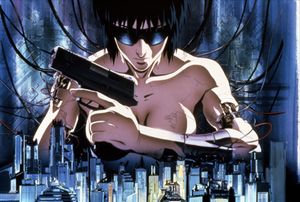Ghost in the Shell: Difference between revisions
(overall revision, with some added links) |
m (oops, link fix) |
||
| Line 1: | Line 1: | ||
[[Image:Ghost in the Shell poster.jpg|right|300px]] | [[Image:Ghost in the Shell poster.jpg|right|300px]] | ||
'''Ghost in the Shell''' is a [[wp:Ghost in the Shell|cyberpunk franchise]] which started in the 1980s with [[wp:Ghost_in_the_Shell_(manga) |a manga series]] by Masamune Shirow. It became the inspiration for [[Oni]] when [[Credits|Brent Pease]] saw [https://www.imdb.com/title/tt0113568/ the movie adaptation] in a theater in 1995 or 1996. Two of the primary themes of the movie are the feeling of loss of identity due to total cyborgization of the body and the untrustworthiness of one's memories due to the potential for cyberbrain hacking. | '''Ghost in the Shell''' is a [[wp:Ghost in the Shell|cyberpunk franchise]] which started in the 1980s with [[wp:Ghost_in_the_Shell_(manga)|a manga series]] by Masamune Shirow. It became the inspiration for [[Oni]] when [[Credits|Brent Pease]] saw [https://www.imdb.com/title/tt0113568/ the movie adaptation] in a theater in 1995 or 1996. Two of the primary themes of the movie are the feeling of loss of identity due to total cyborgization of the body and the untrustworthiness of one's memories due to the potential for cyberbrain hacking. | ||
Oni's main character Konoko was originally a cyborg in the early development of the game. She also had altered memories in [[Oni/Early Story|this early story]], and since the title "Oni" was considered temporary at the time, a final title of "[[wikt:mnemonic#Adjective|Mnemonic]] Shadow" was considered for the game. Eventually the working title became the permanent title, and meanwhile the story was rewritten, turning Konoko into an organically-augmented person instead of a cyborg. The notion of altered memories was removed from the plot as well. | Oni's main character Konoko was originally a cyborg in the early development of the game. She also had altered memories in [[Oni/Early Story|this early story]], and since the title "Oni" was considered temporary at the time, a final title of "[[wikt:mnemonic#Adjective|Mnemonic]] Shadow" was considered for the game. Eventually the working title became the permanent title, and meanwhile the story was rewritten, turning Konoko into an organically-augmented person instead of a cyborg. The notion of altered memories was removed from the plot as well. | ||
Revision as of 20:59, 21 March 2022
Ghost in the Shell is a cyberpunk franchise which started in the 1980s with a manga series by Masamune Shirow. It became the inspiration for Oni when Brent Pease saw the movie adaptation in a theater in 1995 or 1996. Two of the primary themes of the movie are the feeling of loss of identity due to total cyborgization of the body and the untrustworthiness of one's memories due to the potential for cyberbrain hacking.
Oni's main character Konoko was originally a cyborg in the early development of the game. She also had altered memories in this early story, and since the title "Oni" was considered temporary at the time, a final title of "Mnemonic Shadow" was considered for the game. Eventually the working title became the permanent title, and meanwhile the story was rewritten, turning Konoko into an organically-augmented person instead of a cyborg. The notion of altered memories was removed from the plot as well.
Konoko is clearly based on Ghost in the Shell's main character Motoko Kusanagi, however Konoko is much more emotional than the impassive Major. The similarity between Konoko's boss Griffin and Chief Aramaki from GitS has been noted. Konoko's neural link with Shinatama is likely based upon the brain implant which Section 9 members use to communicate securely with each other. Shinatama herself may be inspired by the android Operators of Section 9, which originally come from the manga.
Although Ghost in the Shell's cyberpunk atmosphere is famous and was intended to be an influence on Oni's look, very little of it is evident in the game's final appearance, which was revised during development to be less stereotypically sci-fi than its early look. Some examples of the cyberpunk style can still be found in Oni, e.g. Damocles and the inside of the Syndicate Mountain Compound.
